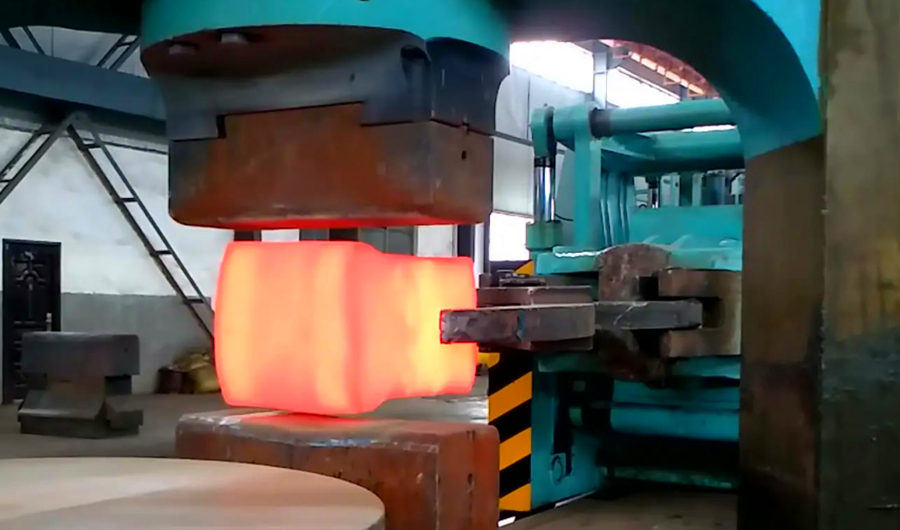As we know, Titanium is an extremely active metal and easily polluted by hydrogen, oxygen and carbon, any of these substances can affect the titanium alloy, so it is essential to control the item from the material, equipment, process, test and maintenance and so on. The process of heat treatment of titanium alloys must be done under strict control, in addition to using a vacuum furnace with argon protection, titanium alloys must be heated in an oxidizing atmosphere. This process involves precise controls and needs to remove the oxide layer on the surface of the workpiece. Reasonable alloying and heat treatment can effectively improve the properties of titanium alloys. There are many heat treatment methods, for Grade5 titanium alloy, annealing, quenching aging and chemical heat treatment are commonly used.
Annealing
Annealing is the only heat treatment method for pure titanium and α titanium alloy. Annealing is suitable for all kinds of titanium alloys to eliminate stress and improve alloy plasticity and stable microstructure. The annealing process is used for various titanium alloys. The purpose of annealing is to improve the plasticity of the material and stabilize its structure. The process may be carried out in three forms: stress-relief annealing, recrystallization annealing, and double annealing.
Annealing is done in air furnace, or annealing in the inert gas furnace or vacuum furnace if there is a requirement for surface contamination of parts. During isothermal annealing, a converter or air cooling should be used if the size of the part is too large to avoid too large microstructure due to too slow cooling speed. When double annealing, air cooling after the first heating, titanium parts should be dispersed cooling, forced air cooling if necessary to avoid too slow cooling speed affect the performance.
Annealing of Grade 5 Titanium
| Clasa | Titanium sheet/strip | Titanium bar/wires | ||||
| Temperature | Time/min | Cooling | Temperature | Time | Cooling | |
| Clasa 5 | 700℃-870℃ | 15-60 | Air cooling | 700℃-800℃ | 60-120 | Air cooling |
Note: Air cooling or slower cooling. When the double annealing, β transition temperature below 15 ~ 30℃ for 1 ~ 2h, air cooling or faster cooling, and then 705-760 ℃ for 1 ~ 2h, air cooling.
The control parameters of heat treatment of titanium alloy include solution temperature, solution time, cooling mode (water quench, oil quench, furnace cooling), and aging temperature. Different titanium alloys require different annealing temperatures. If β annealing or β solution heat treatment is required, Gr.5 alloy or other α-β type alloy shall be held for at least 30min above the β transition temperature of the batch of parts (30±15) ℃, and then cooled to room temperature in air or inert gas, not allowed with furnace cooling. If water quenching is required, it should be kept at 730 ~ 760℃ for 1 ~ 3h after water quenching before the second annealing.

Annealing is the only heat treatment method for pure titanium and α titanium alloy. Annealing is suitable for all kinds of titanium alloys to eliminate stress and improve alloy plasticity and stable microstructure. The annealing process is used for various titanium alloys. The purpose of annealing is to improve the plasticity of the material and stabilize its structure. The process may be carried out in three forms: stress-relief annealing, recrystallization annealing, and double annealing.
Annealing is done in air furnace, or annealing in the inert gas furnace or vacuum furnace if there is a requirement for surface contamination of parts. During isothermal annealing, a converter or air cooling should be used if the size of the part is too large to avoid too large microstructure due to too slow cooling speed. When double annealing, air cooling after the first heating, titanium parts should be dispersed cooling, forced air cooling if necessary to avoid too slow cooling speed affect the performance.
Annealing of Grade 5 Titanium
| Clasa | Titanium sheet/strip | Titanium bar/wires | ||||
| Temperature | Time/min | Cooling | Temperature | Time | Cooling | |
| Clasa 5 | 700℃-870℃ | 15-60 | Air cooling | 700℃-800℃ | 60-120 | Air cooling |
Note: Air cooling or slower cooling. When the double annealing, β transition temperature below 15 ~ 30℃ for 1 ~ 2h, air cooling or faster cooling, and then 705-760 ℃ for 1 ~ 2h, air cooling.
The control parameters of heat treatment of titanium alloy include solution temperature, solution time, cooling mode (water quench, oil quench, furnace cooling), and aging temperature. Different titanium alloys require different annealing temperatures.If β annealing or β solution heat treatment is required, Gr5 alloy or other α-β type alloy shall be held for at least 30min above the β transition temperature of the batch of parts (30±15) ℃, and then cooled to room temperature in air or inert gas, not allowed with furnace cooling. If water quenching is required, it should be kept at 730 ~ 760℃ for 1 ~ 3h after water quenching before the second annealing.
Stress-relief Annealing
Stress-relief tempering of titanium heating and insulation shall be in accordance with the standard. After insulation, the parts shall be cooled in air or inert gas or with the furnace. The heating temperature of stress relief annealing should not exceed the aging temperature or stage 2 annealing temperature for titanium alloys that have been treated with a solution and aged or underwent double annealing.
The temperatures used for stress relief annealing are lower than those for recrystallization, and the annealing time is generally shorter than for recrystallization. This process is performed to reduce residual stresses during fabrication. The process produces optimum combinations of strength, ductility, and dimensional stability. It can be used to reduce the undesirable residual stress during subsequent operations, including machining and heat treatment. It is ideal for dual-phase titanium alloys and can also improve their resistance to stress corrosion. But if you want to avoid heat treatment, this method is not recommended for you.
This process can be carried out at a temperature above the beta transus temperature (beta transition), which is the point at which the alpha phase disappears and the microstructure transforms to a cubic-like structure. This method is used to improve the mechanical properties of titanium alloy parts that need to be shaped into complex shapes.
Stress-relief annealing of Grade 5 Titanium
| Alloys | Temperature | Time/min |
| Clasa 5 | 480℃ -650℃ | 60-240 |
Note: Stress relief annealing can be completed simultaneously at 760 ~ 790℃ with hot forming.
Isothermal Annealing
Isothermal annealing provides the best plasticity and thermal stability. It is a good choice for two-phase titanium alloys that contain high amounts of b-stabilized elements. The process requires heating the alloy above recrystallization temperature and transferring it to a lower-temperature furnace. The heat preserved during this process is transferred to the alloy’s surface by air cooling. This process can be repeated several times to achieve the desired result.
Recrystallization Annealing
The recrystallization annealing process is a method of adjusting the temperature for a specific type of titanium alloy to eliminate basic stresses. The goal of recrystallization annealing is to achieve the desired plasticity and strength properties. The temperature for recrystallization annealing is usually between 450 and 650℃.
During the tensile annealing process, the recrystallization of a titanium alloy occurs simultaneously with a dislocation slip. This is known as a double yield phenomenon. The annealing temperature of 920℃increases strength, while decreasing plasticity. After recrystallization, a secondary phase is precipitated. Prolonged annealing time is not significant in determining the final mechanical properties of titanium alloys.
Quench Aging
Quenching aging is the main way of heat treatment strengthening of Ti6Al4V titanium alloy, which uses phase transformation to produce strengthening, also known as strengthening heat treatment. After solution treatment, titanium alloy parts should be aging treatment according to the provisions (see the table below). After aging, the parts are cooled in air or inert gas or with the furnace.
Quench aging of Gr.5 titanium
| Clasa | Temperature | Time/h |
| Clasa 5 | 480℃ -690℃ | 2-8 |
Chemical Heat Treatment
Chemical heat treatment of titanium alloy is mainly to improve wear resistance, thermal stability and surface strength. As we know, titanium alloy has a large friction coefficient and poor wear resistance (generally about 40% lower than steel), and its contact surface is easy to bond and causes friction corrosion. Titanium alloy has strong corrosion resistance in oxidizing medium, but poor corrosion resistance in reducing medium (hydrochloric acid, sulfuric acid, etc.). To improve these properties, electroplating, spraying and chemical heat treatment, i.e. nitriding, oxygenation and other methods can be used. After nitriding, the hardness of the nitriding surface is 2-4 times higher than that without nitriding, which can obviously improve the wear resistance of the alloy and improve its corrosion resistance in reducing medium. The corrosion resistance of the alloy can be increased 7~9 times by oxygenation, but the disadvantage is that there is some loss of plasticity and fatigue strength.


